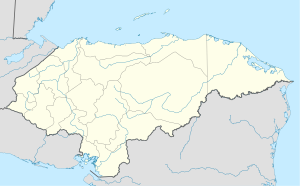Trujillo, Honduras
| Trujillo | |||
|---|---|---|---|
| Municipality | |||

Collage of Trujillo, Honduras
|
|||
|
|||
| Coordinates: 15°55′N 86°00′W / 15.917°N 86.000°WCoordinates: 15°55′N 86°00′W / 15.917°N 86.000°W | |||
| Country |
|
||
| Departament | Colón | ||
| Area | |||
| • Total | 957 km2 (369 sq mi) | ||
| Population (2015) | |||
| • Total | 62,559 | ||
| • Density | 65/km2 (170/sq mi) | ||
Trujillo is a city and a municipality on the northern Caribbean coast of the Honduran department of Colón, of which the city is the capital.
The municipality has a population of about 30,000 (2003). The city is located on a bluff overlooking the Bay of Trujillo. Behind the city rise two prominent mountains, Mount Capiro and Mount Calentura. Three Garifuna fishing villages—Santa Fe, San Antonio, and Guadelupe—are located along the beach.
Trujillo has received plenty of attention as the potential site of a proposed Honduran charter city project, according to an idea originally advocated by American economist Paul Romer. Often referred to as a Hong Kong in Honduras, and advocated by among others the Trujillo-born Honduran president Porfirio Lobo Sosa, the project has also been met with skepticism and controversy, especially due to its supposed disregard for the local Garifuna culture.
Christopher Columbus landed in Trujillo on August 14, 1502, during his fourth and final voyage to the Americas. Columbus named the place "Punta de Caxinas". It was the first time he touched the Central American mainland. He noticed that the water in this part of the Caribbean was very deep and therefore called the area Golfo de Honduras, i.e., The Gulf of the Depths (see: Bay of Honduras).
The history of the modern town begins in 1524, shortly after the conquest of Mexico by Hernán Cortés. Cortés sent Cristóbal de Olid to find a Spanish outpost in the region, and he established a town named Triunfo de la Cruz in the vicinity. When Olid began using the town as his base for establishing his own realm in Central America, Cortés sent Francisco de las Casas to remove him. Las Casas lost most of his fleet in a storm, but he was nevertheless able to defeat Olid and restore the region to Cortés. Upon assuming control, Las Casas decided to relocate the town to its present location, because the natural harbor was larger. At the same time, Triunfo de la Cruz was renamed Trujillo. His deputy, Juan López de Aguirre was charged with establishing the new town, but he sailed off, leaving another deputy, named Medina, to found the town. In the coming years Trujillo became more important as a shipment point for gold and silver mined in the interior of the country. Because of its sparse population, the city also became a frequent target of pirates.
...
Wikipedia



